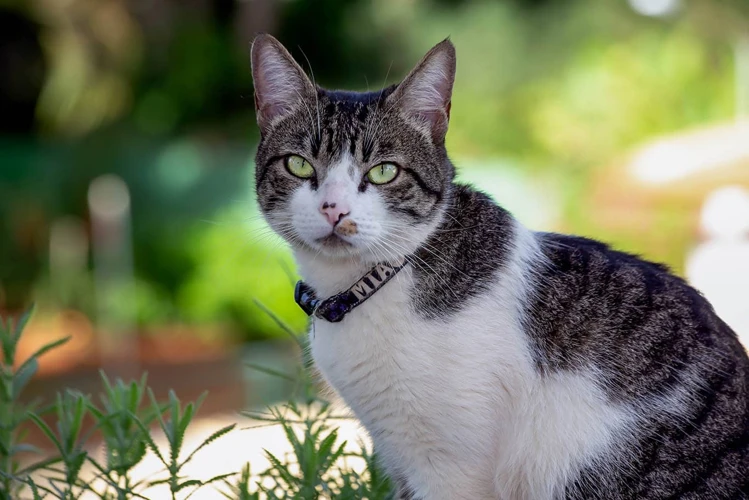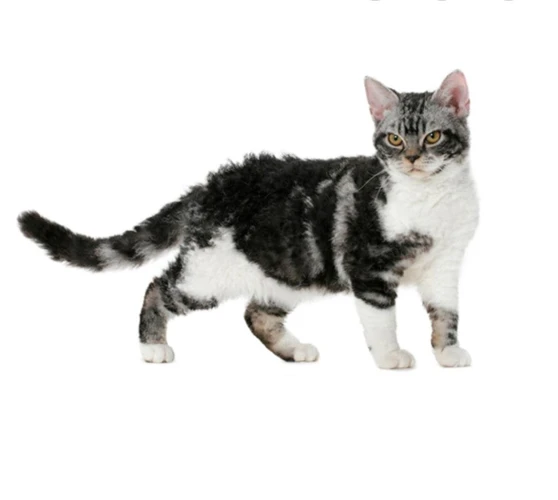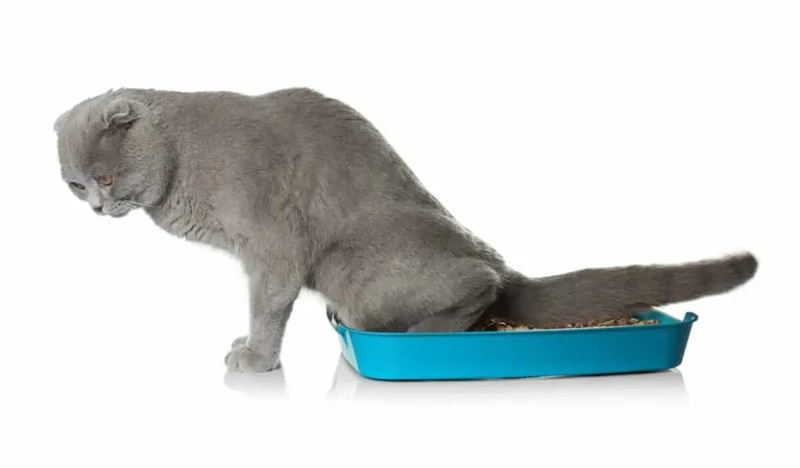Introduction: Getting to Know Your American Wirehair

Getting to Know Your American Wirehair
American Wirehair is a unique breed of cat known for their coarse and wiry fur. They are a medium-sized cat with a muscular build and distinctive coat texture. They were first discovered in upstate New York in the 1960s and have since become a popular breed among cat lovers.
The American Wirehair is a friendly and affectionate cat breed that enjoys being with their owners. They are playful and intelligent, and they love to explore their surroundings. They are also known for being independent and self-sufficient, making them excellent pets for busy owners who cannot be at home all day.
To ensure that your American Wirehair is healthy and happy, it is essential to understand their unique needs and behavior, especially when it comes to their litter box habits. In the next sections, we will discuss the importance of understanding your American Wirehair’s litter box behavior and how you can manage any potential litter box problems.
If you have an American Wirehair kitten, you can also check out our article on American Wirehair kitten litter training tips to help get them started on the right paw.
It’s crucial to provide the best possible litter box for your American Wirehair. To pick the best one, check out our article on best litter box for American Wirehair to make an informed decision.
Here are some factors that affect your American Wirehair’s litter box behavior that you should consider to prevent litter box problems.
The Importance of Understanding Your American Wirehair’s Litter Box Behavior

As a pet owner, you want to make sure your American Wirehair is happy and healthy. One area that often gets overlooked is their litter box behavior. Understanding your American Wirehair’s litter box behavior is crucial as it can provide insight into their overall health and wellness. In this section, we will delve into why litter box behavior is important, and what factors can affect it. We will also take a look at signs of litter box problems and how to manage them. By the end, you will have a better understanding of how to create a happy and healthy litter box environment for your beloved pet. And if you’re looking for more detailed information on positive reinforcement litter training, cleaning your American Wirehair’s litter box, transitioning to a new litter box, dealing with litter problems, toilet training your American Wirehair or providing adequate litter boxes, be sure to check out some of our other articles on the topic.
Why is Litter Box Behavior Important?
Understanding your American Wirehair’s litter box behavior is important for both you and your cat’s well-being. Proper litter box behavior ensures that your cat is healthy and happy, while improper behavior can indicate a variety of underlying issues, such as medical problems, anxiety, stress or environmental issues.
As a pet owner, it is important to know what to expect from your cat’s litter box behavior. Being able to identify changes in behavior, or signs of potential problems, can help you intervene early and avoid health or behavioral issues down the line.
By understanding the reasons behind different litter box behaviors, you can take necessary steps to create an optimal litter box environment for your cat. Here are some of the reasons why litter box behavior is important:
- It can indicate potential health problems: Changes in litter box behavior, such as not covering feces or straining while urinating, could be signs of underlying medical problems, such as urinary tract infections or other urinary problems. It is important to monitor your cat’s litter box habits to spot any potential health issues early.
- It can be a sign of anxiety or stress: Changes to your cat’s environment, such as moving to a new home, can make cats anxious and stressed and lead to litter box problems. If your cat is going outside the litter box, it could be a sign that they are feeling anxious or stressed. Identifying these signs early can help you address the root cause of the behavior.
- It can affect your cat’s overall cleanliness and hygiene: A clean litter box can help prevent infections and other health problems in your cat. As such, it is important to clean the litter box regularly to ensure proper hygiene and cleanliness for your cat.
- It can improve your cat’s quality of life: A properly managed litter box environment can make your cat feel safe, secure, and comfortable. As such, understanding and addressing your cat’s litter box behavior issues can improve their overall quality of life.
Ultimately, by understanding your American Wirehair’s litter box behavior and taking the necessary steps to ensure their health and happiness, you can create a positive and harmonious living environment for both you and your feline friend.
Understanding Your Cat’s Natural Instincts
Understanding your American Wirehair’s natural instincts is key to understanding their behavior, especially when it comes to litter box habits. As descendants of wild cats, domestic cats have retained many of their innate instincts, including the instinct to bury their waste to avoid attracting prey or predators. Even though your American Wirehair may never encounter those dangers, this instinct is deeply ingrained in their behavior.
Another instinct that affects litter box behavior is their territorial nature. Domestic cats mark their territory by depositing their scent, usually through urine, in areas they consider their own. This is why some cats may refuse to use a litter box that has already been used by another cat, or may develop a preference for a certain type of litter box or location.
Cats are creatures of habit and routine, and thrive on familiarity and predictability in their environment. Any changes to their litter box, litter, or location can be stressful for them. This includes changes in their household, such as a new pet or a move to a new home.
Understanding your American Wirehair’s natural instincts can help you anticipate their behavior and address any litter box problems that may arise. Providing a clean and accessible litter box, using a litter that they prefer, and maintaining a predictable routine can all help keep your cat happy and healthy.
It’s also important to note that every cat is unique and may have their own preferences and quirks. Observing your American Wirehair’s behavior and preferences can help you make adjustments to their litter box setup and routine. By providing a comfortable and familiar litter box environment, you can help your American Wirehair maintain good litter box habits.
Positive reinforcement training can also be a helpful way to encourage good litter box habits in your American Wirehair. By rewarding them for using their litter box, you can reinforce this behavior and encourage them to continue using it. In the next section, we will explore the factors that can affect your American Wirehair’s litter box behavior and how to address any problems that may arise.
Factors That Affect Litter Box Behavior

When it comes to your American Wirehair’s litter box behavior, there are various factors that can influence their habits. Understanding and addressing these factors can make a significant difference in your cat’s health and well-being. So, let’s take a closer look at some of the aspects that can affect your American Wirehair’s litter box behavior and what you can do to make sure their needs are met. To avoid any future problems related to litter box, it is important you first get to know your pet’s behavior. For a brief overview of American Wirehair litter box behavior in general, check out this article.
1. Location and Accessibility of Litter Box
One of the primary factors that can affect your American Wirehair’s litter box behavior is the location and accessibility of the litter box. It is important to place the litter box in a location that is easily accessible for your cat. The litter box should be placed in a quiet and private area for your cat to feel comfortable while using it.
1. Placement: For instance, if the litter box is placed in a busy area of the house with high traffic and noise, your cat may avoid using it. Similarly, if the litter box is placed in a dark corner with no light, it may deter your cat from using it. It is important to choose a well-lit and quiet location for the litter box.
2. Accessibility: Accessibility is another crucial factor to consider when it comes to the litter box. The litter box should be easily accessible for your cat at all times. If your cat is elderly, has mobility issues, or is a kitten, it is important to choose a litter box with low sides that are easy to climb into and out of.
3. Number and location of litter boxes: Depending on the size of your house, it may be necessary to have more than one litter box. As a rule of thumb, one litter box per cat plus an additional litter box is recommended. Place the litter boxes in different areas of the house to provide options for your cat.
By taking into account the location and accessibility of the litter box, you can help create an environment where your American Wirehair can feel comfortable using it. If you’re experiencing litter box problems with your cat, it might be due to the location or accessibility of the litter box. For more information on how to manage litter box problems, you can visit our article on American Wirehair litter problems. If you’re transitioning your American Wirehair to a new litter box, you can read our article on transitioning American Wirehair litter box. For those who are toilet training their American Wirehair, read our article on American Wirehair toilet training pros and cons.
2. Type of Litter Box and Litter
One key factor that can affect your American Wirehair’s litter box behavior is the type of litter box and litter that you choose for them. It’s important to consider your cat’s preferences and natural instincts when selecting these items.
Litter Box Types: There are several types of litter boxes available, including open trays, covered boxes, and self-cleaning litter boxes. Some cats prefer the privacy and security provided by a covered litter box, while others may feel more comfortable with the open tray design. It’s important to provide your American Wirehair with a litter box that matches their preferred style.
Litter Types: There are also several types of litter to choose from, including clumping, non-clumping, and biodegradable options. Some cats may prefer a specific texture or scent, so it’s important to experiment with different types until you find one that your American Wirehair is comfortable using. Additionally, be aware that certain litters may contain harmful chemicals or additives, so it’s important to choose a safe and non-toxic option.
When selecting litter box and litter types, also consider the size of your cat. A larger cat may feel cramped in a small litter box, while a smaller cat may struggle with a litter box that is too large. Additionally, if you have multiple cats, make sure to provide enough litter boxes to accommodate all of them.
In addition to considering your cat’s preferences, there are also practical factors to consider when selecting litter box and litter types. For example, a covered litter box may help contain odors, while a self-cleaning litter box can save time on cleaning. However, these options may also be more expensive, so it’s important to consider your budget as well.
Choosing the right combination of litter box and litter types can help create a comfortable and appealing environment for your American Wirehair. By considering your cat’s preferences and natural instincts, you can help ensure that they have a positive litter box experience.
3. Number of Litter Boxes
Providing the appropriate number of litter boxes for your American Wirehair is an essential factor in managing their litter box behavior. Ideally, you should have one litter box per cat, plus one extra. This means that if you have two American Wirehairs, you should have three litter boxes available.
Why is the number of litter boxes important? Having only one litter box in the house can lead to territorial conflicts between cats. The dominant cat may prevent the submissive cat from using the litter box, which can cause stress and anxiety for the submissive cat. Additionally, if one litter box becomes dirty or inaccessible, your cats may choose to eliminate in inappropriate areas.
Where should you place the litter boxes? Place the litter boxes in different locations around your home, ensuring that they are easily accessible and in quiet, low-traffic areas. Some cats prefer a more private area to eliminate, while others don’t mind a little company. Experiment with different locations to find out what your American Wirehair prefers.
What type of litter box should you use? Aside from the number and location of the litter boxes, the type of litter box is also important. Some cats prefer open litter boxes, while others prefer covered ones for privacy. Some cats prefer shallow boxes, and others prefer deeper ones. Experiment with different types of litter boxes to find what works best for your American Wirehair.
What should you do if you notice litter box problems? If you notice your American Wirehair is eliminating outside of the litter box, consider adding an additional litter box in a different location. Pay attention to the frequency your cat uses each box to determine which box may be preferred. Additionally, monitor the cleanliness of each litter box, as dirty litter boxes may discourage your American Wirehair from using them.
Providing multiple litter boxes in your home for your American Wirehair is an important factor in managing their litter box behavior. Experiment with different locations and types of litter boxes to see what works best for your cat to ensure they have a comfortable and healthy environment.
4. Cleanliness of Litter Box
The cleanliness of the litter box is a crucial factor affecting your American Wirehair’s litter box behavior. Cats are fastidious creatures and prefer to eliminate in a clean environment. Regular cleaning of the litter box helps to prevent odors and litter box aversions.
Keeping your cat’s litter box clean is easy and requires a simple routine. You should scoop out your cat’s feces and urine clumps once or twice a day, and replace the litter every two to three weeks. This routine will ensure that the litter box stays clean, and your American Wirehair will always have a fresh and inviting space to use.
Here’s a table outlining the recommended cleaning routine for your American Wirehair’s litter box:
| Cleaning Task | Frequency |
|---|---|
| Scoop out feces and urine clumps | Once or twice a day |
| Replace litter completely | Every two to three weeks |
Note that some cats are more particular than others and may require more frequent cleaning. If you notice that your American Wirehair is avoiding the litter box despite your cleaning routine, you may want to increase the frequency of cleaning.
In addition to regular cleaning, it’s essential to use the right litter box and litter for your cat. Large, uncovered litter boxes are best for your American Wirehair, as they offer more room and promote better ventilation. Clumping litter is also ideal as it is easy to scoop and facilitates the removal of urine and feces.
A clean litter box is vital for your American Wirehair’s health and happiness. By following a regular cleaning routine and providing appropriate litter and litter boxes, you can create a comfortable, inviting space for your pet to use.
Signs of Litter Box Problems

As a cat owner, it’s important to pay attention to any changes in your American Wirehair’s litter box behavior. Noticing any irregularities can help you address potential problems before they become serious. Here are some signs that your cat may be experiencing litter box problems:
1. Choosing Inappropriate Areas to Eliminate
One common sign that your American Wirehair may be having litter box problems is if they are choosing inappropriate areas to eliminate. This could include areas such as carpets, furniture, or even laundry. If you notice this behavior, it is important to address it as soon as possible.
Here are some possible reasons why your cat may be choosing inappropriate areas to eliminate:
- They may be experiencing a medical issue that is causing discomfort while using the litter box.
- Their litter box may not be clean enough for their liking, causing them to seek out alternative areas.
- The litter box may be in an inconvenient location, making it difficult for your cat to access when they need to eliminate.
- There may not be enough litter boxes in the household, causing competition or difficulty sharing between cats.
- Your cat may be marking their territory, especially if there are other cats or animals in the household.
If your cat is choosing inappropriate areas to eliminate, here’s how you can help:
- Take your cat to the veterinarian to make sure there are no underlying medical issues.
- Make sure the litter box is cleaned regularly, at least once a day for most cats.
- Consider adding additional litter boxes to the household, especially if you have more than one cat.
- Place the litter box in a convenient location that is easily accessible for your cat.
- If your cat is marking their territory, consider spaying or neutering them and providing appropriate scratching posts and toys to promote healthy territorial behavior.
Remember, it’s important to address litter box problems as soon as possible to avoid further behavior issues and potential health problems for your cat.
2. Not Covering Urine or Feces
If your American Wirehair isn’t covering urine or feces in the litter box, it could be a sign of a litter box problem. Not covering waste is not just an aesthetic problem – it can also be a hygiene problem and lead to unpleasant odors. Here are some possible reasons for this behavior:
List of Possible Reasons for Not Covering Urine or Feces:
- Dirty litter box: Cats are clean animals, and if the litter box is not clean enough for their tastes, they may choose not to cover their waste.
- Unsatisfactory litter: If your cat is not comfortable with the texture or smell of the litter, they may not want to cover their waste with it.
- Stress: Just like humans, cats can get stressed, and this can lead to changes in their behavior. Stress can be caused by various things such as changes in environment, new pet, new family member, or illness.
- Medical problems: Medical problems like arthritis can make it difficult for your cat to move around, so they may have trouble trying to cover their waste. Also, digestive issues can lead to softer stool that can be difficult for your cat to cover properly.
If your American Wirehair is not covering their waste, you might want to consider addressing the underlying issue that is causing this behavior. Keep the litter box clean by scooping daily and replacing the litter entirely once a week. Also, try different litter types to see what your cat prefers. If stress is the issue, try to reduce the stressors in your cat’s environment as much as possible. Lastly, take your cat to the vet if you suspect medical issues. Checking for medical problems is essential because some illnesses could lead to bigger issues in the future if not treated early.
By identifying and addressing the potential reasons for your American Wirehair’s failure to cover their waste, you can create a comfortable and healthy litter box environment for your furry friend.
3. Going Outside the Litter Box
Finding urine or feces outside of the litter box is a common problem that many American Wirehair owners may encounter. It is important to address this problem quickly to prevent it from becoming a habit for your cat and to maintain a clean and healthy environment for both your pet and your family.
Reasons for Going Outside the Litter Box
There are numerous reasons why your cat may choose to eliminate outside of the litter box. Some of the common reasons are:
| 1. | Dirty litter box: | If the litter box is not clean, your cat may find it unpleasant to use and choose to eliminate elsewhere. |
| 2. | Medical problems: | Urinary tract infections, bladder stones, and other medical issues can cause your cat to experience pain while using the litter box. As a result, they may start to avoid the box altogether. |
| 3. | Stress or anxiety: | If your cat is feeling anxious or stressed, they may start to eliminate outside of the litter box as a way to cope with their emotions. |
| 4. | Litter box access: | If your cat has difficulty accessing the litter box due to mobility issues or other obstacles, they may choose to eliminate elsewhere instead. |
Steps to Address Going Outside the Litter Box
Addressing the issue of your cat going outside the litter box will require a systematic approach that takes into account the potential causes mentioned above. Here are some steps you can take to address the issue:
| 1. | Clean the litter box regularly: | Performing regular cleaning of the litter box and changing the litter can entice your cat to begin using it again. |
| 2. | Consult with a veterinarian: | A veterinarian can examine your cat and diagnose any underlying medical conditions that may be causing the problem. They may prescribe medication or recommend a change in diet to help eliminate the issue. |
| 3. | Provide a comfortable and stress-free environment: | Ensuring that your cat has a comfortable and welcoming environment free of stressors can help reduce their anxiety and encourage them to use the litter box. |
| 4. | Offer positive reinforcement: | When your cat uses the litter box, offer praise and treats to encourage them to continue the good behavior. |
By taking these steps, you can help your American Wirehair cat overcome their litter box aversion and create a happier and healthier environment for both you and your furry friend.
4. Straining to Urinate or Defecate
One sign of a potential litter box problem is when your American Wirehair strains to urinate or defecate. This can indicate a partial or complete blockage in the urinary tract or bowels, which can be a medical emergency and requires immediate veterinary attention. It can also be a sign of constipation or other digestive issues.
If your cat is exhibiting this behavior, it’s important to monitor their litter box use and observe their urine and feces for any changes. Look for signs of bloody urine or diarrhea, which can also be indicative of a medical issue.
To alleviate constipation, you can try adding more fiber to your cat’s diet through canned pumpkin or a high-fiber cat food. It’s also important to ensure they are drinking plenty of water. However, if the straining persists or your cat appears to be in pain while urinating or defecating, it’s crucial to seek veterinary care immediately.
Here are some ways to address straining to urinate or defecate:
- Monitor litter box use and observe urine/feces for changes
- Look for signs of bloody urine or diarrhea
- Consult with a veterinarian if the behavior persists or your cat appears to be in pain
- Add more fiber to their diet through canned pumpkin or high-fiber cat food
- Ensure your cat is drinking plenty of water
By addressing any potential medical issues and ensuring your cat has a comfortable and clean litter box environment, you can help prevent litter box problems and promote a happy and healthy cat.
How to Manage Litter Box Problems
As a pet owner, dealing with litter box problems can be quite perplexing. It’s important to understand that litter box issues can be caused by a variety of factors, including medical conditions, environmental factors, and even behavioral issues. Before deciding on a course of action, it’s crucial to identify the root cause of the problem. In this section, we’ll highlight some effective ways to manage litter box problems and create a healthy and happy environment for your American Wirehair cat. Let’s dive in!
1. Address Medical Issues
A vital step for managing litter box problems in American Wirehairs is to address any underlying medical conditions. The first thing to do is to schedule an appointment with a veterinarian to diagnose and treat any medical issues.
The table below outlines some medical conditions that could lead to litter box issues and their corresponding symptoms:
| Medical Condition | Symptoms |
|---|---|
| Urinary Tract Infection (UTI) | Straining to urinate, frequent urination, blood in urine, inappropriate urination |
| Feline Lower Urinary Tract Disease (FLUTD) | Straining to urinate, frequent urination, difficulty passing urine, licking genital region, blood in urine, inappropriate urination |
| Constipation | Straining to defecate, infrequent bowel movements, hard or dry stools, inappropriate defecation |
| Gastrointestinal Issues | Vomiting, diarrhea, lack of appetite, lethargy, weight loss, inappropriate elimination |
It’s important to note that some of these medical conditions can be life-threatening and require immediate attention. Additionally, it’s not always easy to detect medical issues in cats, so observation of your American Wirehair’s behavior is crucial. For instance, if you notice your cat straining in the litter box or making more frequent visits to the litter box, it’s essential to take them to the vet as soon as possible.
Adopting a preventative approach can also help keep your American Wirehair healthy and reduce the likelihood of litter box problems. This approach involves providing proper nutrition, offering plenty of fresh water, providing exercise opportunities, and scheduling regular wellness exams with your veterinarian. By doing so, you can help ensure that your American Wirehair lives a long, healthy, and happy life free from litter box issues.
2. Evaluate Environmental Factors
Evaluating environmental factors is crucial in managing litter box problems in your American Wirehair. These could include a change in their daily routine, household stressors, or new pets in the house. It’s important to identify and address these issues to help your cat feel more comfortable and confident in using their litter box.
Here are some examples of environmental factors to consider:
- Has there been a change in the household routine or schedule? Cats thrive on routine and may become stressed or anxious if their daily schedule is disrupted.
- Are there any new pets in the household? It’s important to introduce new pets to your American Wirehair slowly and carefully to avoid any stress or anxiety that may cause litter box problems.
- Is the litter box in a busy or noisy area of the house? Cats prefer quiet and private areas to use the litter box, so consider moving it to a more secluded area if needed.
- Is there a lack of available hiding spots for your cat? American Wirehairs are known for their love of hiding, so make sure there are plenty of hiding spots they can access to reduce anxiety and stress.
- Are there any household stressors, such as renovations or a new baby? Any changes to the home environment can cause stress and anxiety for cats, so it’s important to monitor their behavior and adjust accordingly.
Taking the time to evaluate these environmental factors and making changes as needed can go a long way in helping your American Wirehair feel more comfortable and confident in using their litter box. Remember to be patient and consistent in addressing these factors, and don’t hesitate to seek guidance from a veterinarian or behaviorist if needed.
3. Clean the Litter Box Regularly
One of the most important factors in maintaining a healthy litter box environment for your American Wirehair is regular cleaning. This not only helps to prevent bad odors and litter box problems but also ensures the overall health and hygiene of your cat.
How often should you clean the litter box?
Cleaning frequency depends on the number of cats you have and the size of the litter box. As a general rule, it’s recommended to scoop the litter box at least once a day. If you have multiple cats sharing the same litter box, you may need to clean it more frequently.
What are the steps to properly clean the litter box?
Follow these simple steps to clean your American Wirehair’s litter box:
| Step | Description |
|---|---|
| Step 1 | Wear gloves and empty the litter box into a plastic bag. |
| Step 2 | Scrub the inside of the litter box with warm water and mild soap. |
| Step 3 | Rinse the litter box with clean water and dry it thoroughly. |
| Step 4 | Add clean litter to the box, making sure that the depth is at least 2-3 inches. |
| Step 5 | Dispose of the used litter and plastic bag in an outdoor trash can. |
It’s important to note that disinfectants should not be used on the litter box, as they can be harmful to your cat. Additionally, avoid using bleach or other strong cleaners, as they can leave behind residual scents that may discourage your cat from using the litter box.
What are the consequences of not cleaning the litter box regularly?
When the litter box is not cleaned regularly, bacteria and parasites can thrive, leading to potential health problems for both you and your cat. Dirty litter boxes can also lead to offensive odors, and unpleasant litter box experiences for your cat.
By committing to regular litter box cleaning, you create a happy and healthy environment that your American Wirehair will appreciate.
4. Try Different Types of Litter and Litter Boxes
One approach to managing litter box problems in your American Wirehair is to try different types of litter and litter boxes. Not all cats have the same preferences, and finding what works best for your American Wirehair can go a long way in keeping them using the litter box consistently.
There are many options when it comes to litter, including clumping clay, non-clumping clay, recycled paper, and more. Some cats may prefer a certain texture or scent, so it may be helpful to try a few different types to see what your American Wirehair responds well to. Additionally, some cats may have an aversion to scented litters, so it may be best to stick with unscented options.
Another factor to consider is the type of litter box you are using. Some cats may prefer an open box, while others may feel more secure in an enclosed box. The size and shape of the box can also make a difference – if your American Wirehair is having trouble fitting comfortably in the box, they may choose to eliminate outside of it.
To help you keep track of what works best for your cat, here is a table of different litter and litter box options to consider:
| Litter Type | Pros | Cons |
|---|---|---|
| Clumping Clay | Easy to clean, good odor control | Dust can be an issue, some cats may not like the texture |
| Non-Clumping Clay | Low-dust option, affordable | Doesn’t control odor as well, can require more frequent scooping |
| Recycled Paper | Environmentally friendly, low-dust option | May not be as absorbent as clay litter, can be more expensive |
| Corn/Wheat/Pine | Biodegradable, good odor control | May be more expensive, some cats may not like the texture/scent |
When it comes to litter boxes, it’s important to consider the size, shape, and access points of the box, as well as any potential preferences your cat may have for open or enclosed designs. Some options to consider include:
| Litter Box Type | Pros | Cons |
|---|---|---|
| Standard/Open | Simple and easy to use, accessible | May not offer much privacy, litter can be kicked out of the box |
| Enclosed | Provides more privacy, can help contain litter | Can be more difficult to clean, some cats may not like the enclosed feeling |
| Top-Entry | Reduces litter tracking, can be easier to clean | May not be as accessible for senior or disabled cats |
| Self-Cleaning | Reduces litter box maintenance, can be helpful for multiple cat households | Can be more expensive, may require more upkeep |
Remember that trial and error is key when it comes to finding the best litter and litter box options for your American Wirehair. Don’t be afraid to experiment with different options until you find what works best for your cat.
5. Provide Adequate Number of Litter Boxes
Cats are known to be very territorial animals, and one of the best ways to make your American Wirehair feel at home is to provide them with a comfortable and tidy litter box. However, when it comes to litter box behavior, one size does not fit all. Providing an adequate number of litter boxes is crucial to ensuring your cat happily uses them. So, how many litter boxes do you need?
The general rule of thumb is one litter box per cat, plus one extra. So, if you have two American Wirehairs, having three litter boxes in different locations throughout your home is recommended. This gives each cat their own designated territory and helps reduce litter box conflicts and stress.
To make things more clear, take a look at this simple table:
| Number of Cats | Number of Litter Boxes Recommended |
|---|---|
| 1 | 2 |
| 2 | 3 |
| 3 | 4 |
| 4 | 5 |
Of course, this recommendation is not set in stone. You may find that one litter box is enough for your solo American Wirehair. Or, you may have multiple cats that have no problem sharing a single litter box. The key is to observe your cat’s behavior and adjust accordingly. If you notice litter box problems, such as inappropriate elimination or refusal to use the litter box, adding more boxes may help solve the issue.
Having multiple litter boxes also ensures that one is always readily available, especially if your American Wirehair is older or may have mobility issues. Having litter boxes on different floors or in different rooms also makes it more convenient for your cat and helps avoid accidents outside of the litter box.
By providing your American Wirehair with an adequate number of litter boxes, you can create a comfortable and stress-free environment for them to happily use the litter box and maintain their hygiene.
6. Offer Positive Reinforcement
Positive reinforcement can be a powerful tool to encourage your American Wirehair to use the litter box and to reinforce good litter box behavior. Here are some examples of positive reinforcement:
| Reward | Behavior to Reinforce |
|---|---|
| Treats | Using the litter box |
| Verbal praise | Using the litter box |
| Petting or cuddling | Using the litter box |
| Playtime | Using the litter box consistently or not going outside the litter box |
It’s important to note that positive reinforcement should be given immediately after the desired behavior occurs, so your American Wirehair can make the connection between the behavior and the reward. It’s also important to use consistent rewards and to not punish your cat for litter box problems, as this can cause more stress and anxiety and lead to further litter box issues.
Using positive reinforcement can create a positive association with the litter box and encourage good litter box behavior in your American Wirehair.
7. Consult with a Veterinarian or Behaviorist
If you have tried all the solutions discussed above, and your American Wirehair still has litter box problems, you may want to consider consulting with a veterinarian or behaviorist. A veterinarian can rule out any medical issues that may be causing your cat’s inappropriate elimination, such as urinary tract infections or bowel obstructions. A behaviorist can provide insights into your cat’s behavior and help you find a solution that works for both you and your pet.
During the consultation with the veterinary or behaviorist, be prepared to provide a detailed history of your cat’s litter box behavior, including when the behavior started, what kind of inappropriate elimination is occurring, how often it happens, and any changes in the cat’s environment. The consultant may also ask you about your cat’s diet, exercise routine, and daily schedule.
Based on your discussion, the veterinary or behaviorist may recommend different treatment options such as medication, different litter types, or behavioral modification training. Keep in mind that successfully addressing litter box issues may take time and patience, and it may involve trying different solutions until you find one that works best for your American Wirehair.
Bringing in a veterinary or behaviorist can be a valuable step in addressing litter box problems, especially if the issue persists despite your best efforts. With the right guidance, you can help your cat overcome litter box issues and create a happy and healthy environment for both you and your pet.
Conclusion: Creating a Happy and Healthy Litter Box Environment
Ensuring a happy and healthy litter box environment for your American Wirehair cat is crucial for their overall well-being and household harmony. By implementing the tips and strategies discussed in this article, you can address litter box problems and prevent future issues from arising.
Regular litter box maintenance is key in creating a clean and inviting space for your kitty. Scooping the litter box daily, cleaning it out completely every 1-2 weeks, and replacing the litter as needed can help prevent litter box aversion.
Additionally, evaluating environmental factors such as litter box location, accessibility, and type of litter can make a world of difference in your cat’s litter box behavior. Some cats may prefer a covered litter box while others may prefer an open one. Some may prefer fine-grain litter while others may prefer a coarser texture. Experimenting with different litter boxes and types of litter can help you determine your cat’s preferences.
Remember to offer positive reinforcement when your cat uses the litter box correctly. This can come in the form of verbal praise, treats, or playtime. Positive reinforcement helps strengthen good litter box habits and can improve overall litter box behavior.
Finally, if all else fails, don’t hesitate to consult with a veterinarian or behaviorist for additional guidance. They can help identify any underlying medical issues and suggest behavioral modification techniques to address litter box problems.
Creating a happy and healthy litter box environment for your American Wirehair cat requires patience, diligence, and a willingness to try different strategies. By focusing on your cat’s needs and preferences, you can create a litter box environment that promotes good litter box behavior and strengthens the bond between you and your furry companion.
Frequently Asked Questions
1. How do I know if my American Wirehair is having litter box problems?
Signs of litter box problems include going outside the litter box, not covering urine or feces, choosing inappropriate areas to eliminate, and straining to urinate or defecate.
2. How often should I clean my American Wirehair’s litter box?
It is recommended to clean the litter box daily, but at least every other day as American Wirehairs are known for their cleanliness and may avoid a dirty litter box.
3. How many litter boxes should I have for my American Wirehair?
It is recommended to have one more litter box than the number of cats in the household. So if you have one American Wirehair, you should have at least two litter boxes.
4. What type of litter box should I use for my American Wirehair?
It is recommended to use an uncovered, large litter box as American Wirehairs are known for their size. They may feel cramped in a covered litter box and avoid it.
5. Can changing the type of litter cause litter box problems?
Yes, changing the type of litter can cause litter box problems. It is important to slowly transition your American Wirehair to a new type of litter over a period of a few weeks.
6. Can medical issues cause litter box problems?
Yes, medical issues such as urinary tract infections or digestive problems can cause litter box problems. It is important to rule out any medical issues before addressing litter box problems as a behavioral issue.
7. How can positive reinforcement help with litter box problems?
Positive reinforcement, such as offering treats or praise when your American Wirehair uses the litter box correctly, can encourage good litter box behavior and reinforce good habits.
8. Can stress cause litter box problems?
Yes, stress can cause litter box problems. Environmental stressors such as a new pet or rearranging furniture can affect your American Wirehair’s litter box behavior. It is important to evaluate any environmental stressors when addressing litter box problems.
9. Should I punish my American Wirehair for litter box problems?
No, punishment can actually worsen litter box problems and cause increased stress and anxiety for your American Wirehair. It is important to address the underlying cause of litter box problems and use positive reinforcement instead of punishment.
10. When should I consult with a veterinarian or behaviorist?
If your American Wirehair’s litter box problems persist despite environmental changes and addressing medical issues, it may be time to consult with a veterinarian or behaviorist for further guidance and support.







